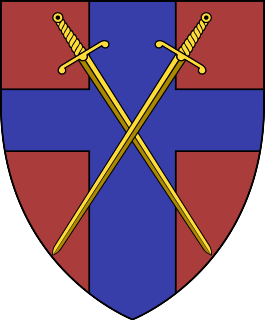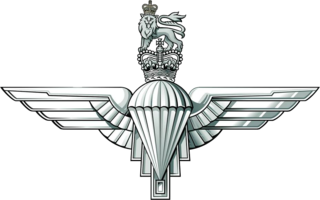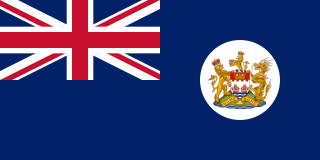Related Research Articles

The Infantry of the British Army, comprises 49 infantry battalions, from 19 regiments. Of these, 33 battalions are part of the Regular army and the remaining 16 a part of the Army Reserve. The British Army's Infantry takes on a variety of roles, including armoured, mechanised, air assault and light.

There have been two formations named British Army of the Rhine (BAOR). Both were originally occupation forces in Germany, one after the First World War and the other after the Second World War. Both formations had areas of responsibility located around the German section of the River Rhine.

The Parachute Regiment, colloquially known as the Paras, is an airborne infantry regiment of the British Army. The first battalion is part of the operational command of the Director Special Forces. The other battalions are the parachute infantry component of the British Army's rapid response formation, 16 Air Assault Brigade. The Paras, along with the Guards, are the only line infantry regiment of the British Army that has not been amalgamated with another unit since the end of the Second World War.

The 6th Division is an infantry division of the British Army. It was first established by Arthur Wellesley, 1st Duke of Wellington for service in the Peninsular War as part of the Anglo-Portuguese Army and was active for most of the period since, including the First World War and the Second World War. The modern division was reformed on 1 February 2008, as a deployable two star Headquarters for service in Afghanistan during Operation Herrick. The division was officially reformed with a parade and flag presentation at York on 5 August 2008 and then disbanded in April 2011.
The 2003 Defence White Paper, titled Delivering Security in a Changing World, set out the future structure of the British military, and was preceded by the 1998 Strategic Defence Review (SDR) and the 2002 SDR New Chapter, which responded to the immediate challenges to security in the aftermath of the September 11 attacks in 2001. Published under the then Secretary of State for Defence, Geoff Hoon, the report effectively introduced a series of cutbacks to core equipment and manpower and the scaling back of a series of future capital procurement projects. This was justified due to the implementation of a policy termed Network Enabled Capability. The review also outlined a major restructuring and consolidation of British Army Infantry regiments.

The Royal Gurkha Rifles (RGR) is a rifle regiment of the British Army, forming part of the Brigade of Gurkhas. Unlike other regiments in the British Army, RGR soldiers are recruited from Nepal, which is neither a dependent territory of the United Kingdom nor a member of the Commonwealth.

British Forces Overseas Hong Kong comprised the elements of the British Army, Royal Navy and Royal Air Force stationed in British Hong Kong. The Governor of Hong Kong also assumed the position of the Commander-in-chief of the forces and the Commander British Forces in Hong Kong took charge of the daily deployment of the troops. Much of the British military left prior to the handover of Hong Kong to China in 1997. The present article focuses mainly on the British garrison in Hong Kong in the post Second World War era. For more information concerning the British garrison during the Second World War and earlier, see the Battle of Hong Kong.

The Punjab Regiment is second oldest regiments still in service in the Indian Army, and is the most senior regional infantry regiment. It was formed from the 2nd Punjab Regiment of the British Indian Army in 1947 and has taken part in various battles and wars since, winning numerous honours for the same.

The 5th Indian Infantry Division was an infantry division of the Indian Army during World War II that fought in several theatres of war and was nicknamed the "Ball of Fire". It was one of the few Allied divisions to fight against three different armies - the Italian, German and Japanese armies.

The 5th Infantry Brigade was a regular infantry brigade of the British Army that was in existence since before the First World War, except for a short break in the late 1970s. It was an Airborne Brigade from the early 1980s until amalgamating with 24th Airmobile Brigade, in 1999, to form 16 Air Assault Brigade.

The 42nd Infantry Brigade, also known as 42 Brigade, was a brigade of the British Army.
The Malaya Command was a formation of the British Army formed in the 1920s for the coordination of the defences of British Malaya, which comprised the Straits Settlements, the Federated Malay States and the Unfederated Malay States. It consisted mainly of small garrison forces in Kuala Lumpur, Penang, Taiping, Seremban and Singapore.

The Border Regiment was a line infantry regiment of the British Army, which was formed in 1881 under the Childers Reforms by the amalgamation of the 34th (Cumberland) Regiment of Foot and the 55th (Westmorland) Regiment of Foot.
This is the Operation Herrick ground order of battle, which lists any British ground forces that have taken part in the duration of Operation Herrick between 2002 and 2014.
The Order of battle of the East African campaign shows the ground forces of both sides in East Africa on the date that the Italians declared war on Britain and France, 10 June 1940 and for the British and Commonwealth forces involved in the 1941 offensive.

The Royal Thai Marine Corps or RTMC are the marines of the Royal Thai Navy. The Royal Thai Marine Corps was founded in 1932, when the first battalion was formed with the assistance of the United States Marine Corps. It was expanded to a regiment in 1940 and was in action against communist guerrillas throughout the 1950s and 1960s. During the 1960s the United States Marine Corps assisted in its expansion into a brigade. The Royal Thai Marine Corps saw action on the Malaysian border in the 1970s, and has now been increased to four brigades.
The 3rd (Lahore) Division was an infantry division of the British Indian Army, first organised in 1852. It saw service during World War I as part of the Indian Corps in France before being moved to the Middle East where it fought against troops of the Ottoman Empire.
Army 2020 Refine was the name given to the restructuring of the British Army, in light of the Strategic Defence and Security Review 2015.
In September 1939, the British Army was in process of expanding their anti-aircraft and mobile assets. Among these new changes was the formation of Anti-Aircraft Command which was formed on 1 April 1939, and the 1st Armoured Division formed in 1937. The list below will include the British Army units, colonial units, and those units which were in the process of formation.
The 2nd Malaya Infantry Brigade was a regular infantry brigade formed in 1940 with its headquarters in Singapore following the wartime expansion and reinforcement of Malaya Command. The Brigade participated in the Malayan Campaign and the Battle of Singapore against the Japanese until the surrender of the garrison in February 1942.
References
- 1 2 3 Milestones of Flight Archived 2011-01-05 at the Wayback Machine
- ↑ Heritage appraisal of King's College Archived 2012-09-08 at the Wayback Machine
- ↑ Queen's Royal Surreys
- ↑ Glasgow Herald, 25 January 1927